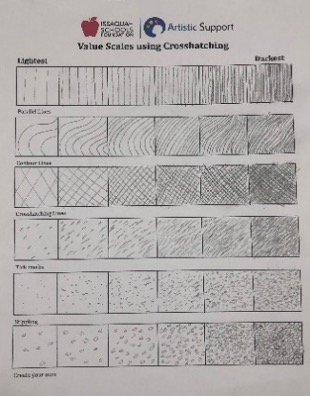Students will draw a building using hatching techniques to create shadow and imply depth. Recommended for 4th Graders.
Line: a long narrow mark or stroke made on or in a surface.
Form: a 3-dimensional figure that exists in space instead of flat on paper.
Shape: a two-dimensional (flat), limited to height and width.
Value: (Hue/Shade/Tint): Color (Hue) and variations of the color. Shades are color+black, tints are color+white. Muted colors have gray added.
Contrast: refers to the arrangement of opposite elements, or using very different qualities next to each other to create visual interest, excitement and drama. E.g. smooth/rough textures, light/dark colors, or thick/thin lines.
Pattern: uniform repetition of any element of art: in this case: color, shape & line.
Rhythm: created by movement, implied through the repetition of line in a non-uniform but organized way to show 2 & 3-dimensions.
Crosshatching: the use of multiple parallel marks, laid over another set of parallel marks going in a different direction, to darken color.
Craftsmanship: A way of working that includes following directions, demonstrates neatness and the proper use of tools.
Gradation: a gradual change in value and/or color.
Hatching: the use of multiple small parallel marks which create a color value.
Linear perspective: a technique to simulate depth in a 2-dimensional picture plane. Objects that appear to recede get smaller, nearer the horizon, and are overlapped.
Cross-hatching is a method of line drawing that shows shadows. Light is shown by the white of the paper, while shadow is created by crossed lines. The closer together the lines, the darker value you will create.
Using the value scale below, see how the light end at left uses a simple pattern of parallel lines spaced widely and evenly apart to represent light. The dark end (right) layers crisscrossing lines to represent shadow. The use of densely packed lines creates deep shadow and is how we show depth on a flat page.



Lesson written by Juliette Ripley-Dunkelberger.
Alexander, K. (2003). Drawing & painting activities: using masterworks as inspiration. Glenview, IL: Crystal Productions.
21st Century Thinking Skills
Thinking flexibly, persisting, questioning, creating, innovating, listening with empathy, taking responsible risks, observing, making connections, visualizing, sequencing, predicting, comparing/contrasting, determining main idea, finding evidence, problem solving, cause and effect, determining point of view, decision making.
WA State Learning Standards
(VA:Cr2.1.4) a. Explore and invent art-making techniques and approaches.
(VA:Cr2.2.4) a. When making works of art, utilize and care for materials, tools, and equipment in a manner that prevents danger to oneself and others.
(VA:Cr2.3.4) a. Document, describe, and represent regional constructed environments.
(VA:Cr3.1.4) a. Revise artwork in progress on the basis of insights gained through peer discussion. This happens if you share out about students’ choices of craftsmanship during the lesson.
(VA:Re7.2.4) a. Analyze components in visual imagery that convey messages. This happens when you explain how to create the illusion of depth in a 2-dimensional picture plane.
(VA:Re8.1.4) a. Interpret art by referring to contextual information and analyzing relevant subject matter, characteristics of form, and use of media.
(VA:Re9.1.4) a. Apply one set of criteria to evaluate more than one work of art.
(VA:Cn11.1.4) a. Through observation, infer information about time, place, and culture in which a work of art was created.
Please note: These lesson plans are intended for non-profit use only. Use of these plans for commercial purposes should give attribution to the Issaquah Schools Foundation and be accompanied by a nominal donation at www.isfdn.org/donate. Thank you.
Fueling Success for Every Student, Every School